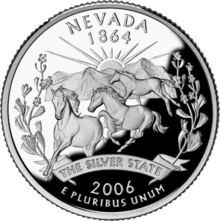Sheldon National Wildlife Refuge
| Sheldon National Wildlife Refuge | |
|---|---|
|
IUCN category IV (habitat/species management area) | |
|
Desert vegetation near the eastern edge of the refuge | |
 | |
| Location | Humboldt and Washoe counties, Nevada |
| Nearest city | Lakeview, Oregon |
| Coordinates | 41°48′00″N 119°12′04″W / 41.7998937°N 119.2010306°WCoordinates: 41°48′00″N 119°12′04″W / 41.7998937°N 119.2010306°W[1] |
| Area | 573,504 acres (232,089 ha)[2] |
| Established | 1931 |
| Governing body | U.S. Fish and Wildlife Service |
| Website | Sheldon NWR |
The Sheldon National Wildlife Refuge is a 573,504-acre (232,089 ha) national wildlife refuge located on the northern border of the U.S. state of Nevada. A very small part extends northward into Oregon. It is managed by the United States Fish and Wildlife Service as the Nevada component of the Sheldon-Hart Mountain National Wildlife Refuge Complex, which is headquartered in Lakeview, Oregon. The Sheldon Refuge is noted for its population of wild horses.
In 1931, the refuge was established under executive order to carry out three central goals: First, the refuge was to provide a habitat for the "antelope" (more properly called the pronghorn), an animal whose population was in decline during the early 1900s. Second, conservation efforts were put forth to protect native fish, wildlife and plants. Finally, the refuge was to serve as an inviolate migratory bird sanctuary.[3]
Advocates characterize Sheldon as one of the few intact sagebrush steppe ecosystems in the Great Basin, one that hosts a variety of wildlife endemic to the unique environment.[4] Desert fishes, greater sage-grouse, migratory birds, mule deer and the pygmy rabbit are all residents of the refuge.
Description
The Sheldon National Wildlife Refuge occupies an arid zone of volcanic terrain. Rockhounds search for semiprecious stones such as fire opals. Geothermal hot springs provide some water. The dominant ecosystem plant life consists of drought-tolerant species such as sagebrush, juniper, mountain mahogany, bitterbrush, and aspen. The elevation ranges from 4,100 feet (1,200 m) to 7,200 feet (2,200 m) above sea level.

In this forbidding landscape lives a large population of free-range fauna, with the American mustang, the so-called "wild horse" of the American West, being the best known. There are also large herds of mule deer, an estimated 3,500 pronghorn, and a small but self-sustaining population of bighorn sheep.
The bighorn are not strictly native to the Sheldon Refuge, having been extirpated there during the frontier era and successfully reintroduced about 1930.[5] The pronghorn "antelope" played a key role in the history of the Refuge, as approximately 94 percent of the current protected land area was originally set aside as the Charles Sheldon Antelope Range in 1936.[6]
The Refuge is the home of an endemic fish species of limited geographic distribution, the Alvord chub.
Nevada State Route 140 traverses the refuge from east to west and is the only paved road within the refuge. The nearest community of any size is Denio, Nevada, 14 miles from the Refuge's eastern boundary. The nearest divided highway is Interstate 80 in Winnemucca, Nevada, approximately 100 miles to the south.
Controversy
Proposals to cull some of the alleged excess population of mustang in the Sheldon National Wildlife Refuge were drawing public concern as of 2008. The official Fish and Wildlife (USFWS) position, as stated on their Refuge website, was that "horses and burros are not native to Sheldon Refuge. They are descended from domestic stock turned loose around the turn of the twentieth century. They are primarily grass eaters, and their grazing can devastate native vegetation and cause severe damage to riparian habitat."[5] Some private-sector advocates, such as the Sierra Club, agree with the USFWS position.[4]
In response, the American Wild Horse Preservation Campaign has accused the USFWS of conducting "helicopter round-ups during foaling season" in the Sheldon Refuge.[7] The recent history of roundups at the refuge are controversial with indications that many ended up at slaughterhouses. [8]
The population of Sheldon horses are the descendants of horses used by the US Army. Harry Wilson was one of the ranchers that sold horses to the US Cavalry. When the Wilsons owned the Virgin Valley Ranch, they worked with the Army, which provided thoroughbred stallions that were bred with the Wilsons' standardbreds. [9]
Due to the negative impact horses and burros have riparian areas and the resulting strain on native wildlife, Sheldon officials have decided to remove all horses from the Refuge by 2014. [10]
References
- ↑ "Sheldon National Wildlife Refuge". Geographic Names Information System. United States Geological Survey.
- ↑ "Annual Report of Lands as of September 30, 2009" (PDF). United States Fish and Wildlife Service.
- ↑ "US Fish & Wildlife Sheldon National Wildlife Refuge - About". Retrieved 2009-09-10.
- 1 2 "Sheldon National Wildlife Refuge Plan". Sierra Club. Retrieved 2012-03-21.
- 1 2 "Sheldon National Wildlife Refuge". United States Fish and Wildlife Service. Retrieved 2008-07-01.
- ↑ "Bird Checklists of the United States: Sheldon National Wildlife Refuge". United States Geological Survey. Retrieved 2008-07-01.
- ↑ "AWHPC - Sheldon Round-Up, June 2006". American Wild Horse Preservation Campaign. Archived from the original on 2008-05-09. Retrieved 2008-07-01.
- ↑ http://sheldonhorses.wordpress.com/roundups/
- ↑ http://www.royalpeacock.com/virgin-valley/wilson-family-history
- ↑ http://www.fws.gov/sheldonhartmtn/sheldon/horseburro.html
| Wikimedia Commons has media related to Sheldon National Wildlife Refuge. |